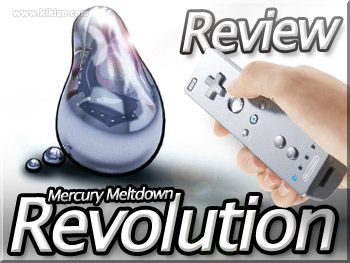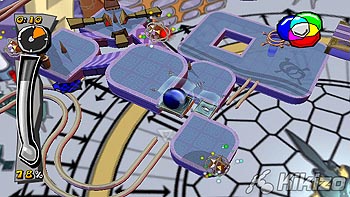Mercury Meltdown Revolution
A great PSP game made better on Wii.
| Version Wii | Developer Awesome | Publisher Ignition | Genre Puzzle |
||||
Mercury Meltdown Revolution is a strangely unique game. Its only direct comparison is with Super Monkey Ball though even a cursory examination will show that simple comparisons do not do justice to the complexity of Mercury. It can also be compared to its predecessor of course, Archer Maclean's Mercury - a PSP launch title back in April 2005. Given the moniker for this title one can reasonably assume that it too was intended to be a launch game for the the console formerly known as the Nintendo Revolution. Instead it was granted additional development time. Was it worth the wait?

Ignition Studios have thus had two years to improve upon on the formula and gameplay of the initial Mercury, nudging it closer towards perfection. Gone is the cold, sterile, abstractness of the first game, replaced by a warm comfort and vibrancy which is most apt considering the role of mercury in measuring temperature. Instead of the realism of the first game there have a bold, cartoon graphical style - almost cel-shaded - which suits the title perfectly.
Unlike the visual makeover, the core mechanic is basically the same - after all, it's not something that could easily be altered. The aim is simple - you control a blob of mercury and must guide it through the level to the exit. Essentially there are 3 goals to each level. You must either exit with a certain percentage of your mercury intact, with all the bonus items or within the time limit. It is worth noting that thankfully these are not all inclusive, so there are no frantic panics and moments of frustration as you try to collect all the bonuses without losing a drop of mercury - indeed there will even be times when it is simpler and quicker to syphon off a blob and sacrifice it in order to reach the more precariously positioned bonuses. You thus often find yourself playing through the level many times, completing one goal each time. This makes for a much more enjoyable experience as you work at a more leisurely pace, only attempting to reach the exit within the time limit once the other objectives have been completed and you know the ideal route through the level.
Unless you have already achieved perfection on each level, there is always the desire for one more go to better your previous attempt. Even then you are coaxed into trying again, thanks in part to the ghost replay feature which dares you to move faster, take more risks and to beat your time. Completing the level with 100% of your mercury or with all the bonuses leads to stamps on the test tubes depicting each level. Achieve the top score for the level and you also get a stopper in your tube, neatly keeping with the laboratory theme. Complete enough levels and the next laboratory becomes accessible. As if the 10 labs - each initially containing 16 stages - was not enough, there are bonus stages to unlock as well as party games. Compared to the Mario Party's of this world, the longevity of these party games is questionable. However as an unexpected extra and a temporary diversion and breather from the harder levels, they cannot be faulted. Whilst tricky at first, the Race game in particular is most interesting - sort of a Wipeout Lite, controlled only by tilting the Wiimote.
It is in the control mechanism where Mercury will stand or fall. Whilst visually and audibly nicer than its predecessor (perhaps understandably given that this is a Wii title whereas the previous game was developed for the PSP), these aspects were never the game's selling point. Its USP lies in controlling a blob of mercury, tilting the game world to roll it around, cajoling it to the exit. If the PSP version was acceptable in this regard, here it is admirable. A shining example of the Wii broadening the gaming experience and bringing motion-sensing to the mass-market. Utilizing the Wiimote only and holding it in a horizontal fashion, tilting it left, right, forwards or back moves the world around, with the mercury responding accordingly. It is simple and intuitive, making games of a similar vein seem clumsy in comparison with their analogue sticks, shoulder buttons and d-pads - especially when you are in-the-zone, performing slow, graceful arcs with the Wiimote as opposed to the frantic button presses of old. Minimal use of the buttons do remain however but they are solely to rotate the camera and zoom in and out.
Introduced gradually as you progress are a host of objects which interact with your mercury, such changing its colour, repulsing it away, or cutting it in half. These can be avoided but typically must be utilized in order to solve some of the puzzles required to complete the levels. Colour plays an important part in the game with various puzzles solvable only if your mercury is a certain colour, such as doors that will only allow green blobs through. Sometimes your must split your mercury, colouring them different primary colours, before merging them back together to create a secondary colour. Although all levels require a steady hand (and some require it exclusively) the best levels also require a good deal of cerebral dexterity too.
Some of the later levels are fiendishly difficult though, especially the hidden bonus rounds. These require not only the lightest of nudges and tilts but also knowledge of the primary and secondary colour combinations, either memorized or via continual pauses to look in the manual and thus upsetting your ebb and flow. Although the colour chart is displayed whilst playing, having to look away and work out what colour combinations you require can waste valuable seconds or even worse, your remaining mercury as it tumbles over the edge.
With fun race-like levels mixed in with some of the more challenging levels though, the balance to the game is just about right. Spend some time with it and going back to similar games on traditional consoles will not quite feel the same any more, at least until you readjust to the lack of motion sensing. Mercury Meltdown Revolution is definitely worth a roll.
A more refined and purer experience than its predecessor, melded effortlessly with the motion sensing capabilities of the Wiimote. It should be easy, right? What could be simpler than tilting the controller? No button presses (other than to adjust the camera), no combos, no analogue stick to move, no multi-button assignments to master.
| ||||||||||||
|

















 Satoru Iwata Video Interview - the late Nintendo president spoke with Kikizo in 2004 as 'Nintendo Revolution' loomed.
Satoru Iwata Video Interview - the late Nintendo president spoke with Kikizo in 2004 as 'Nintendo Revolution' loomed. Kaz Hirai Video Interview - the first of Kikizo's interviews with the man who went on to become global head of Sony.
Kaz Hirai Video Interview - the first of Kikizo's interviews with the man who went on to become global head of Sony. Ed Fries Video Interview - one of Xbox's founders discusses an epic journey from Excel to Xbox.
Ed Fries Video Interview - one of Xbox's founders discusses an epic journey from Excel to Xbox. Yu Suzuki, the Kikizo Interview - we spend time with one of gaming's most revered creators.
Yu Suzuki, the Kikizo Interview - we spend time with one of gaming's most revered creators. Tetris - The Making of an Icon: Alexey Pajitnov and Henk Rogers reveal the fascinating story behind Tetris
Tetris - The Making of an Icon: Alexey Pajitnov and Henk Rogers reveal the fascinating story behind Tetris Rare founders, Chris and Tim Stamper - their only interview? Genuinely 'rare' sit down with founders of the legendary studio.
Rare founders, Chris and Tim Stamper - their only interview? Genuinely 'rare' sit down with founders of the legendary studio. The History of First-Person Shooters - a retrospective, from Maze War to Modern Warfare
The History of First-Person Shooters - a retrospective, from Maze War to Modern Warfare